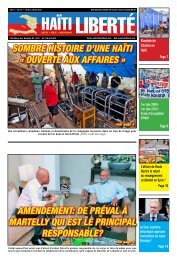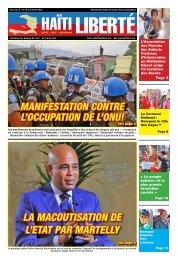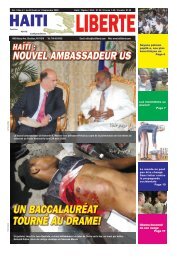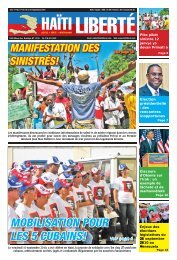VISITE DE SARKOZY EN HAITI ! - Haiti Liberte
VISITE DE SARKOZY EN HAITI ! - Haiti Liberte
VISITE DE SARKOZY EN HAITI ! - Haiti Liberte
Create successful ePaper yourself
Turn your PDF publications into a flip-book with our unique Google optimized e-Paper software.
This Week in <strong>Haiti</strong><br />
500 women march on MINUSTAH<br />
and U.S. Embassy to demand<br />
“Tents, not guns!”<br />
Brian Jackson/Millenials Project<br />
U.S. brags <strong>Haiti</strong> response<br />
is a “Model” while more<br />
than a million <strong>Haiti</strong>ans<br />
remain homeless<br />
Over 500 women marched 7 miles from Carrefour Aviation to the US Embassy in Tabarre.<br />
by Christian Guerrier and Brian<br />
Jackson<br />
Christian Guerrier and Brian<br />
Jackson, both based in the Miami,<br />
Florida area, visited <strong>Haiti</strong> from Feb. 1<br />
- 9. They are with the Millennials Project,<br />
an organization dedicated to the<br />
empowerment of women.<br />
We traveled to <strong>Haiti</strong> with the idea<br />
that women would emerge to lead<br />
in rebuilding and reshaping the country’s<br />
future after the devastating Jan.<br />
12 th earthquake. Arriving by bus from<br />
the Dominican Republic, we stayed in<br />
makeshift tents at Port-au-Prince’s Carrefour<br />
Aviation Base, near the community<br />
of Pont Rouge, where Christian had<br />
lived as a boy.<br />
Prior to our arrival, we had heard<br />
from news reports that women were<br />
having difficulty obtaining the aid that<br />
was being distributed. When we arrived,<br />
it appeared that nobody was receiving<br />
such aid. It was quite clear that the most<br />
pressing need among the hundreds of<br />
thousands of internally displaced was<br />
tents. Having toured much of Port–au–<br />
Prince by car, we had observed no more<br />
than a few hundred tents spread between<br />
a handful of locations. Throughout the<br />
week, we spent the better part of our<br />
time organizing the women at Carrefour<br />
Aviation and going back and forth to<br />
the United Nation’s Mission to Stabilize<br />
<strong>Haiti</strong> (MINUSTAH) Logistics Base, in the<br />
airport’s northeast corner, where most of<br />
the foreign aid groups were stationed.<br />
We spoke with no less than two dozen<br />
representatives from organizations such<br />
as the UN Children’s Fund (UNICEF),<br />
the UN Refugee Agency (UNHCR), the<br />
International Organization for Migration<br />
(IOM), The Red Cross, the World Health<br />
Organization (WHO) and the UN World<br />
Food Programme (WFP), none of whom<br />
could tell us how many tents were available,<br />
where they were, or why they<br />
were not being distributed.<br />
The general consensus was that<br />
IOM was primarily responsible for the<br />
handling of tents, however, when we<br />
met with its representative, Louis (no<br />
last name provided), he claimed that the<br />
organization’s resources had dried up,<br />
that there was no cache of tents waiting<br />
for distribution. “Unless the American<br />
people decide to turn the tap back on,<br />
there’s nothing we can do,” he said.<br />
The following day, we met a UN-<br />
HCR representative. The organization<br />
supplies tents for the camps of many<br />
internally displaced people around the<br />
world, but it is not mandated to work<br />
in <strong>Haiti</strong>. He explained to us that UN-<br />
HCR had offered to provide additional<br />
tents, but was told by the IOM that it<br />
had “more than enough.”<br />
We finally attempted to have a<br />
group of eight women from the Pont<br />
Rouge community admitted to the MI-<br />
NUSTAH Base to speak directly with the<br />
representatives of these NGOs, who generally<br />
did not want to cooperate with the<br />
Millenials Project, it being a new U.S.-<br />
based organization that they had never<br />
heard of. These women (called the <strong>Haiti</strong>an<br />
Women’s Leadership Council) could<br />
assess and articulate the needs of their<br />
community better than any foreign team<br />
of aid workers possibly could, and they<br />
were willing and able to coordinate the<br />
distribution of materials. Despite making<br />
the effort of traveling to the MINUSTAH<br />
Base, the women were not even allowed<br />
in the gate of the walled-in compound.<br />
The two of us went into the base to talk<br />
with NGO representatives, but they refused<br />
to admit the women’s delegation.<br />
It was turned away.<br />
After getting no help and no answers<br />
except those that we ourselves<br />
were able to deduce from a series of<br />
verbal inconsistencies, we decided with<br />
the women to organize a public demonstration.<br />
Since the <strong>Haiti</strong>an Women’s<br />
Leadership Council would not be admitted<br />
into the MINUSTAH base to voice<br />
their concerns, we chose to have a<br />
mass march to the base the following<br />
day. Throughout the week, huge rallies<br />
had been taking place each afternoon<br />
at an amphitheater located in the Carrefour<br />
Aviation area. By Thursday, Feb.<br />
4, we had amassed about 500 people<br />
from the community.<br />
The march took place on Friday,<br />
Feb. 5 th , led by a banner reading January<br />
12 Movement to Liberate <strong>Haiti</strong>an<br />
Women. Beginning at Pont Rouge, the<br />
crowd of over 500 women marched 20<br />
abreast, with a number of men providing<br />
a protective security perimeter<br />
around the women. The demonstrators<br />
came first to the airport, stopping all<br />
traffic along the way. They then proceeded<br />
to the Central Directorate of the<br />
Judicial Police (DCPJ), which has also<br />
been President René Préval’s residence<br />
and office since the disaster.<br />
The demonstrators briefly blocked<br />
the DCPJ’s entrance as they marched by.<br />
<strong>Haiti</strong>an police began hitting the men<br />
guarding the demonstration’s perimeter<br />
with clubs. Despite this provocational<br />
brutality, the protestors remained<br />
commendably peaceful throughout the<br />
march. People joined the procession as<br />
it passed. The protestors joined hands,<br />
singing traditional <strong>Haiti</strong>an songs and<br />
chanting the slogan “Tents, not guns!”<br />
in Kreyòl. The march paused again in<br />
front of the MINUSTAH Base, and then<br />
finally continued on to the U.S. Embassy<br />
in Tabarre. The entire march from<br />
Pont Rouge to Tabarre is about 7 miles.<br />
In a radio address, President<br />
Préval claimed to have heard about the<br />
march and commented that it should<br />
not happen again.<br />
On the evening of Feb. 7, it rained<br />
for the first time since the earthquake,<br />
auguring the rainy season which starts<br />
in March. The vast majority of residents<br />
in <strong>Haiti</strong>’s “sheet cities” still have<br />
no tents to shelter them.<br />
On Feb. 9, the January 12 Movement<br />
to Liberate <strong>Haiti</strong>an Women, again<br />
with the Millenials Project’s support,<br />
staged a sit–in on the Champs de Mars<br />
outside the Plaza Hotel, where CNN had<br />
been staying. About 50 demonstrators<br />
held signs reading “Tents Now, Politics<br />
Later” and “End U.N. Racism.”<br />
The two groups have initiated<br />
plans for another demonstration in<br />
Port-au-Prince to be held on Mar. 8,<br />
International Women’s Day. Women’s<br />
organizations from around <strong>Haiti</strong> have<br />
been invited to help organize the event,<br />
which organizers hope will bring out<br />
thousands of women from around <strong>Haiti</strong><br />
and its capital.<br />
Brian Jackson/Millenials Project<br />
The demonstrators had received<br />
no aid and needed tents before the<br />
rainy season.<br />
by Bill Quigley.<br />
Despite the fact that over a million<br />
people remained homeless in <strong>Haiti</strong><br />
one month after the earthquake, the<br />
U.S. Ambassador to <strong>Haiti</strong>, Ken Merten,<br />
is quoted at a State Department briefing<br />
on February 12 as saying: “In terms of<br />
humanitarian aid delivery…frankly,<br />
it’s working really well, and I believe<br />
that this will be something that people<br />
will be able to look back on in the future<br />
as a model for how we’ve been<br />
able to sort ourselves out as donors<br />
on the ground and responding to an<br />
earthquake.”<br />
What? <strong>Haiti</strong> is a model of how<br />
the international government and donor<br />
community should respond to an<br />
earthquake? The Ambassador must be<br />
overworked and need some R&R. Look<br />
at the facts.<br />
The UN Office for the Coordination<br />
of Humanitarian Affairs (OCHA)<br />
reported Feb. 11 there are still 1.2<br />
million people living in “spontaneous<br />
settlements” in and around Port-au-<br />
Prince as a result of the Jan. 12 earthquake.<br />
These spontaneous settlements<br />
are sprawling camps of homeless <strong>Haiti</strong>an<br />
children and families living on the<br />
ground under sheets.<br />
Over 300,000 are in camps in<br />
Carrefour, nearly 200,000 in Port au<br />
Prince, and over 100,000 each in Delmas,<br />
Pétionville and Léogane according<br />
to the UN.<br />
About 25,000 people are camped<br />
out on one golf course in Pétionville.<br />
Hundreds of thousands of others are<br />
living in soccer fields, church yards,<br />
on hillsides, in gullies, and even on the<br />
strips of land in the middle of the street.<br />
The UN has identified over 300 such<br />
spontaneous settlements. The Red<br />
Cross reports there are over 700.<br />
The UN reported that barely one<br />
in five of the people in camps have<br />
received tents or tarps as of Feb. 11.<br />
Eighty percent of the hundreds of thousands<br />
of children and families still live<br />
on the ground under sheets.<br />
Many of these camps are huge.<br />
Nineteen of these homeless camps in<br />
the Port au Prince area together house<br />
180,000 people. More than half of these<br />
camps are so spontaneous that there is<br />
no organization in the camp to even<br />
comprehensively report their needs.<br />
Another half a million people have<br />
left Port-au-Prince, most to the countryside.<br />
As a result, there are significant<br />
food problems in the countryside. About<br />
168,000 internally displaced people are<br />
living along the border with the Dominican<br />
Republic, many with families. Others<br />
are in “spontaneous settlements” of<br />
up to a 1000 people.<br />
People living in these densely<br />
populated camps will be asked to move<br />
to more organized settlements outside<br />
the city. Relocation, says the UN, will<br />
be on a voluntary basis.<br />
The U.S. Ambassador knows full<br />
well there are 900 or so aid agencies<br />
are on the ground in <strong>Haiti</strong>. Coordination<br />
and communication between those<br />
agencies and between them and the<br />
<strong>Haiti</strong>an government continues to be a<br />
very serious challenge.<br />
Though many people are trying<br />
hard to meet the survival needs of<br />
<strong>Haiti</strong>, no one besides the Ambassador<br />
dares say that it is a model of how to<br />
respond. Partners in Health director Dr.<br />
Louise Ivers reported on the very same<br />
day that “there is more and more misery”<br />
in Port-au-Prince. Fears of typhoid<br />
and dysentery haunt the camps as the<br />
rainy season looms.<br />
But still the <strong>Haiti</strong>an spirit prevails.<br />
Everyone who has been to <strong>Haiti</strong><br />
since the earthquake reports inspiring<br />
stories of <strong>Haiti</strong>ans helping <strong>Haiti</strong>ans despite<br />
the tragically inadequate response<br />
of the <strong>Haiti</strong>an government and the international<br />
community. That spirit is<br />
something people should admire. Let<br />
me finish with a story that illustrates.<br />
One orphanage outside of Port-au-<br />
Prince, home to 57 children, was promised<br />
a big tent so the children would no<br />
longer have to sleep under the stars. The<br />
tent arrived but without poles to hold it<br />
up. The same group was promised food<br />
from UNICEF. Twelve days later, no food<br />
had arrived. They improvised and constructed<br />
scaffolding to create an awning<br />
over the mattresses lying on the dirt.<br />
They are finding food from anywhere<br />
they can. “We’re holding on,” said the<br />
<strong>Haiti</strong>an director Etienne Bruny, “We’re<br />
used to difficult times.”<br />
<strong>Haiti</strong>ans are holding on despite<br />
the inadequate humanitarian response.<br />
They are the model.<br />
Bill Quigley is the legal director<br />
of the Center for Constitutional Rights<br />
and a frequent visitor to <strong>Haiti</strong> for human<br />
rights work over the past decade.<br />
You can reach him at Quigley77@<br />
gmail.com.<br />
CUNY’s Evening in Solidarity with the<br />
People of <strong>Haiti</strong><br />
On Friday, Feb. 19 at 5:30<br />
p.m., the Professional Staff Congress<br />
(PSC), which represents the<br />
faculty and staff at CUNY, is hosting<br />
an Evening in Solidarity with<br />
the People of <strong>Haiti</strong>. Please join us<br />
for this important opportunity to<br />
expand the public conversation<br />
about the earthquake, to show<br />
our solidarity as a union with the<br />
people of <strong>Haiti</strong>, and to raise money<br />
for rebuilding <strong>Haiti</strong>an universities<br />
and continuing relief work on the<br />
island.<br />
The evening will include <strong>Haiti</strong>an<br />
food and music, as well as a<br />
panel discussion about the political<br />
and economic histories that converged<br />
to make the January 12<br />
earthquake so catastrophic. As we<br />
learned from Hurricane Katrina,<br />
there are no “natural” disasters.<br />
The panel will be followed by an<br />
open discussion, in which we hope<br />
to explore how the earthquake has<br />
and has not been covered in the<br />
media, how it has affected the <strong>Haiti</strong>an<br />
community, and how we as a<br />
union might respond. New York’s<br />
<strong>Haiti</strong>an community includes many<br />
PSC members and CUNY students,<br />
some of whom suffered devastating<br />
losses last month. The event is also<br />
a gesture of solidarity with them.<br />
All are welcome. Please let us<br />
know if you plan to come, because<br />
we need to have an idea of numbers<br />
in ordering food. Come for all<br />
or part of the evening:<br />
5:30-6:30: Dinner.<br />
6:30-8:00: Panel and Discussion.<br />
8:00-9:30: Film.<br />
The event will take place at<br />
the PSC Union Hall, 61 Broadway,<br />
16th floor, in Manhattan. The<br />
building in which we are located<br />
requires photo I.D. for entrance.<br />
Suggested contribution: $40 ($10<br />
for students and those on lower<br />
incomes). All funds raised will go<br />
toward rebuilding <strong>Haiti</strong>an universities<br />
and supporting the relief work<br />
of Doctors without Borders. RSVP:<br />
mberger@pscmail.org or (212)<br />
354-1252.<br />
Vol. 3 No. 31 • Du 17 au 23 Février 2010 Haïti Liberté 9

















